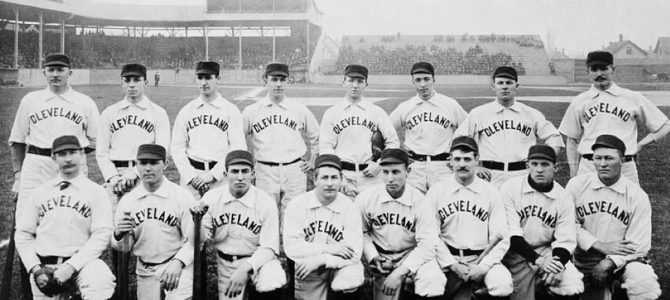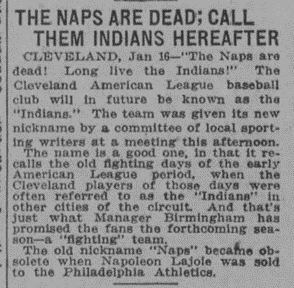
News broke this week that 2021 will be the last season in which Cleveland’s Major League Baseball franchise is known as the Indians. The change had been hinted at since July but was only confirmed Monday with a statement from the team.
Behind the change is a long-running complaint, now boosted by the wave of social justice advocacy in corporate America. It won’t make anyone’s life better or worse in any meaningful sense but will cause a lot of emotion for people on both sides of the issue. The change reflects the concentration of power in sports and the differing priorities of owners and fans.
Regardless of the cause, that change is coming. What happens next is still uncertain, but the choice of a new nickname for the Indians is sure to make for heated discussion in baseball over the next few months.
The owners will surely have focus groups and consultants weighing in and may choose some completely novel name. But of all of our sports, baseball is the most in touch with its history. Instead of something trendy and temporary — looking at you, Toronto Raptors — Cleveland should bring back one of the storied names of the past. In 2022, the American League should include the Cleveland Spiders.
Cleveland’s Team Has Gone By Many Names
Baseball teams used to come and go, and even those with staying power used to change their names fairly often. Cleveland’s American League franchise was called the Bluebirds when the AL became a major league in 1901, but fans often just called them the Blues. The year before, when the AL was still a minor league, they were the Cleveland Lake Shores. They called themselves the Bronchos (sic) in 1902.
After signing Napoleon Lajoie, one of the biggest stars of his era, the team started calling themselves the Cleveland Napoleons — or just “Naps” for short. That name lasted until 1914, when the team dealt the aging Lajoie to the Athletics in the offseason. “Naps” was a fine name for the time, but today conjures up the image of an afternoon snooze, not a batting champion.

The process for finding a new team name was a great deal looser in 1915. Partly, this was due to the fact many of the names teams went by were really just nicknames, often bestowed on them by fans or sportswriters in sort of an early form of crowdsourcing.
Names of old franchises were recycled without regard to intellectual property rights, and nicknames were even shared across sports. Consider, for example, the NFL teams named “New York Yankees” and “Brooklyn Dodgers,” or the NHL team called the “Pittsburgh Pirates,” which would result in a lawsuit today. All were acceptable in a time sports seemed more democratic and less corporate.
In that spirit, Cleveland’s team owner, Charles Somers, met with sportswriters to discuss the problem. According to contemporary news reports, some of the names they considered were Colts, Bucks, Hustlers, Grays, and even Black Sox (this was before that term became associated with the 1919 Chicago White Sox and their game-fixing scandal). Ultimately, none of these were chosen and the team became the Cleveland Indians.
Yet even that name was not set in stone. As the Cleveland Plain Dealer reported the following day, “the club may so conduct itself during the present season as to earn some other cognomen which may be more appropriate.” That sentiment was not uncommon then. Team owners played a role in team nicknames — the franchise was their property, after all — but not always a decisive one.
When George and John Dovey bought the Boston Beaneaters in 1907, they renamed them the Doves, after themselves. It didn’t last, however, and the team became the Braves after a few more name changes. Likewise, the owners of the Phillies tried to promote “Blue Jays” as an alternate nickname in the mid-1940s, but the fans didn’t buy it.
The Famous Spiders
When Cleveland adopted its new moniker in 1915, newspapers reported it was a throwback to “the old fighting days of the early American League period” when Cleveland players were often called “Indians” as an informal nickname. That is true, but it gets the facts a little wrong: the bygone era in question was not the first American League seasons but slightly earlier.
In the 1890s, the National League had a franchise in Cleveland that included Louis Sockalexis, a member of the Penobscot tribe who was probably the first person of Native American ancestry to play Major League Baseball. Although some modern scholars suggest the connection to Sockalexis is a modern retcon to justify the Indians nickname, newspapers in Cleveland and elsewhere were writing about it within days of the 1915 renaming.
Sockalexis’s team was the Cleveland Spiders, and they were one of the dominant teams of their era. After some limited success in the American Association, a short-lived rival to the National League, the Spiders jumped to the NL in 1889. The results were mediocre at first, but they soon improved and finished in second or third in the 12-team league for four out of five years from 1892 to 1896.
The Spiders’ downfall was not the fault of bad players or even bad luck, but of direct malfeasance by their owners, brothers Frank and Stanley Robison. In 1899, the Robisons bought a second National League franchise, the ancestors of today’s St. Louis Cardinals. They named their new team the “Perfectos” and tried to live up to that title by moving every decent player on the Spiders roster to St. Louis.
The predictable result was the Spiders racking up the worst record in major-league history: 20 wins and 134 losses. After the season, the NL contracted from 12 teams to eight, and the Spiders were obvious candidates for the chopping block.
A Tip of the Hat to Tradition
There are many old nicknames for Cleveland’s owners and fans to choose from, but the Spiders, despite their ignominious end, harken back to an image of old-time baseball success. Even the existing Indians color scheme can remain, as the University of Richmond Spiders (and the comic book Spider-Man) show. The tradition of that Spiders franchise is nowhere near as deep as that of the Indians.
No one alive today remembers the city’s major league team playing under any name but Indians, and both of the team’s World Series titles were won as the Indians. Many Tribe fans will grieve the loss of something familiar, a change forced on them by people who mostly do not even support the team or live in the area.
But change will come, welcome or not. Baseball nicknames are not bestowed by fans anymore but by owners and their consultants. Boardroom consensus has taken the place of the former, broader consultations that once determined things like team nicknames. Perhaps it is the inevitable course of technology, mass media, and increasingly valuable merchandising rights.
Rather than ignoring the news or fighting in vain against it, fans of Cleveland baseball and its history should participate in the discussion to come and make the best of what will happen. Fans and sportswriters do not have the power they once had, but they can still influence a team’s owners one way or the other. Remembering the Spiders is the best way to do that.









